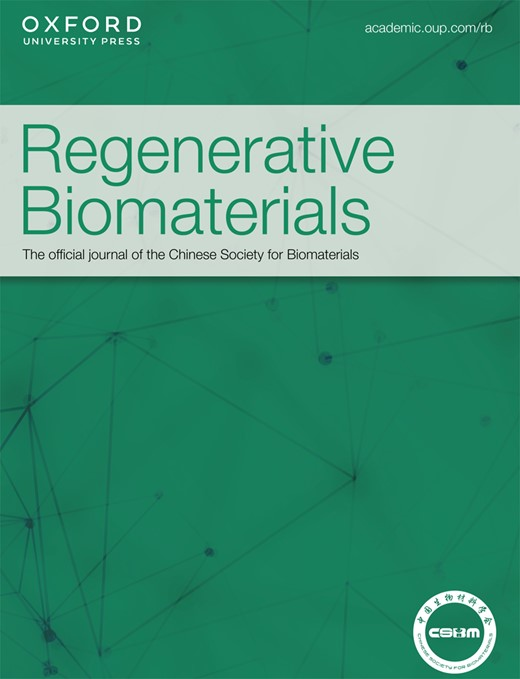Inhibition effect of copper-bearing metals on arterial neointimal hyperplasia via the AKT/Nrf2/ARE pathway in vitro and in vivo
IF 5.6
1区 医学
Q1 MATERIALS SCIENCE, BIOMATERIALS
引用次数: 0
Abstract
In-stent restenosis can be caused by the activation, proliferation, and migration of vascular smooth muscle cells (VSMCs), which affects long-term efficacy of interventional therapy. Copper (Cu) has been proved to accelerate the endothelialization and reduce the thrombosis formation, but few about its inhibition effect on the excessive proliferation of VSMCs. In this study, 316L-Cu stainless steel and L605-Cu cobalt-based alloy with varying Cu content, were fabricated and their effects on surface property, blood compatibility and VSMCs were studied in vitro and in vivo. CCK-8 assay and EdU assay indicated that the Cu-bearing metals had obvious inhibitory effect on proliferation of VSMCs. Blood clotting and hemolysis tests showed that the Cu-bearing metals had good blood compatibility. The inhibition effect of the Cu-bearing metals on migration of cells was detected by Transwell assay. Further studies showed that Cu-bearing metals significantly decreased the mRNA expressions of bFGF, PDGF-B, HGF, Nrf2, GCLC, GCLM, NQO1 and HO1. The phosphorylation of AKT and Nrf2 protein expressions in VSMCs were significantly decreased by Cu-bearing metals. Furthermore, it was also found that SC79 and TBHQ treatments could recover the protein expressions of phospho-AKT and Nrf2, and their downstream proteins as well. Moreover, 316L-Cu stent proved its inhibitory action on the proliferation of VSMCs in vivo. In sum, the results demonstrated that the Cu-bearing metals possessed apparent inhibitory effect on proliferation and migration of VSMCs via regulating the AKT/Nrf2/ARE pathway, showing the Cu-bearing metals as promising stent materials for long-term efficacy of implantation.含铜金属通过体外和体内 AKT/Nrf2/ARE 通路抑制动脉新内膜增生的作用
支架内再狭窄可由血管平滑肌细胞(VSMC)的活化、增殖和迁移引起,从而影响介入治疗的长期疗效。铜(Cu)已被证实能加速血管内皮化并减少血栓形成,但其对血管平滑肌细胞过度增殖的抑制作用却鲜为人知。本研究制作了不同含铜量的 316L-Cu 不锈钢和 L605-Cu 钴基合金,并研究了它们在体外和体内对表面性质、血液相容性和 VSMC 的影响。CCK-8 试验和 EdU 试验表明,含铜金属对 VSMC 的增殖有明显的抑制作用。凝血和溶血试验表明,含铜金属具有良好的血液相容性。Transwell 试验检测了含铜金属对细胞迁移的抑制作用。进一步的研究表明,含铜金属能明显降低 bFGF、PDGF-B、HGF、Nrf2、GCLC、GCLM、NQO1 和 HO1 的 mRNA 表达。含铜金属还显著降低了血管内皮细胞中 AKT 磷酸化和 Nrf2 蛋白的表达。此外,研究还发现 SC79 和 TBHQ 处理可恢复磷酸化 AKT 和 Nrf2 蛋白及其下游蛋白的表达。此外,316L-Cu 支架对体内 VSMC 的增殖也有抑制作用。总之,研究结果表明,含铜金属通过调节 AKT/Nrf2/ARE 通路对 VSMC 的增殖和迁移具有明显的抑制作用,表明含铜金属是一种具有长期植入疗效的支架材料。
本文章由计算机程序翻译,如有差异,请以英文原文为准。
求助全文
约1分钟内获得全文
求助全文
来源期刊

Regenerative Biomaterials
Materials Science-Biomaterials
CiteScore
7.90
自引率
16.40%
发文量
92
审稿时长
10 weeks
期刊介绍:
Regenerative Biomaterials is an international, interdisciplinary, peer-reviewed journal publishing the latest advances in biomaterials and regenerative medicine. The journal provides a forum for the publication of original research papers, reviews, clinical case reports, and commentaries on the topics relevant to the development of advanced regenerative biomaterials concerning novel regenerative technologies and therapeutic approaches for the regeneration and repair of damaged tissues and organs. The interactions of biomaterials with cells and tissue, especially with stem cells, will be of particular focus.
 求助内容:
求助内容: 应助结果提醒方式:
应助结果提醒方式:


